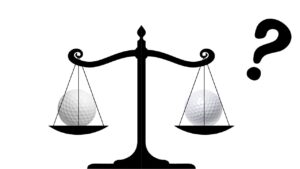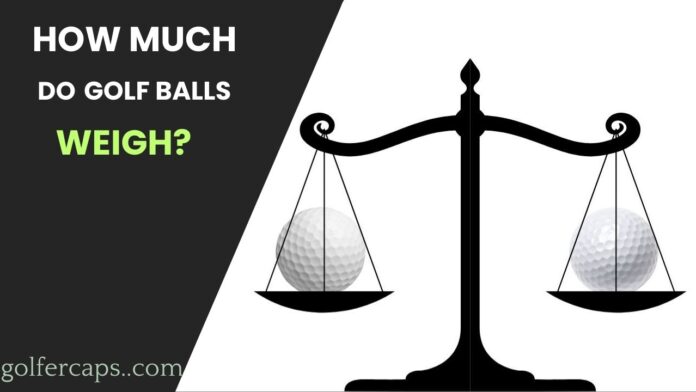Golf is a sport that combines precision, skill, and a deep understanding of the equipment used. Among the essential pieces of gear is the humble golf ball. You might wonder, “How much do golf balls weigh?” This question is more important than it might seem at first glance. The weight of a golf ball can significantly influence your game, from the distance it travels to the control you have over it. Let’s dive into the details and uncover everything you need to know about the weight of golf balls.
How Much Do Golf Balls Weigh?

There are two main answers to this question, depending on whether you’re interested in the regulations or the actual weight you might find on the course:
- Official weight: According to the rules set by the United States Golf Association (USGA), a golf ball cannot weigh more than 1.62 ounces (45.9 grams). [USGA rules on golf balls]
- Actual weight: In practice, most golf balls on the course will weigh close to the maximum weight limit, but there can be slight variations. Some two-piece balls designed for distance might weigh a touch less, while three-piece balls designed for control might be a hair heavier. The difference is usually just a fraction of a gram.
So, to sum up, a golf ball typically weighs around 1.62 ounces, but the exact weight can vary slightly depending on the specific ball.
Read also: Do Golf Balls Go Bad in Water?
How many golf balls weigh 1 pound?

There are about 9.88 golf balls in one pound.
| Number of golf balls | Weight |
|---|---|
| 9.88 | 1 pound |
The weight of a golf ball is crucial for several reasons. Firstly, it directly impacts the distance the ball can travel. Heavier balls tend to carry more momentum, but they also require more force to achieve the same distance as lighter balls. Secondly, the weight affects control and accuracy. A well-balanced ball that adheres to the standard weight will provide consistent performance, which is essential for precision shots.
Read also: Do Golf Balls Expire?
Materials Used in Golf Ball
Golf balls have evolved significantly over the years, and their construction now involves a variety of materials that enhance performance. Here’s a detailed breakdown of the materials used in golf balls:
-
Rubber Core
- Solid Core: Most modern golf balls feature a solid rubber core. This core provides the primary source of the ball’s weight and energy transfer. The solid core allows for greater control and consistency in performance.
- Liquid Core: Some golf balls have a liquid-filled core, which can offer different playing characteristics, such as a softer feel and more spin.
-
Mantle Layers
- Synthetic Rubber: In multi-layered golf balls, mantle layers made from synthetic rubber or similar materials are added between the core and the cover. These layers help to manage the ball’s spin and control, providing a balance between distance and feel.
- Polybutadiene is a specific type of synthetic rubber often used in the mantle layers. It enhances the energy transfer from the clubface to the ball, contributing to longer distances.
-
Outer Cover
- Urethane: Urethane is the preferred material for premium golf balls. It provides a soft feel, excellent durability, and high spin rates, especially around the greens. This cover material is favored by professional and advanced amateur golfers.
- Surlyn: Surlyn is a type of ionomer resin commonly used in the outer cover of golf balls designed for beginners and recreational players. It is more durable than urethane and offers less spin, which helps to reduce hooks and slices.
-
Dimple Pattern
- Aerodynamic Design: While not a material per se, the design of the dimples on a golf ball significantly affects its flight characteristics. The dimples reduce air resistance and help the ball maintain a stable trajectory. The materials used for the cover must support and enhance the effectiveness of these dimples.
-
Adhesives and Fillers
- Epoxy Resins: These are used to bond different layers of the golf ball together. The choice of adhesive affects the ball’s durability and performance.
- Fillers: Various fillers can be added to the core or mantle layers to adjust the weight and other properties of the ball. These filters are often proprietary blends that manufacturers keep as trade secrets.
Types of Golf Balls
Golf balls come in various types, each designed to cater to different playing styles and preferences. The most common types are:
- Two-Piece Golf Balls: These are the most basic and are typically used by beginners. They consist of a solid core and a durable outer cover, providing maximum distance and durability.
- Three-Piece Golf Balls: These balls have an additional layer between the core and the cover, offering better control and spin.
- Four-Piece and Multi-Layered Golf Balls: These are designed for advanced players, providing the best combination of distance, spin, and control.
Factors Influencing Golf Ball Weight
Several factors influence the weight of a golf ball, including the composition of the core, the materials used for the cover, and the manufacturing process. For instance, a solid rubber core will weigh more than a liquid-filled one. Similarly, a thicker urethane cover will add to the ball’s overall weight.
Read also: How Many Golf Balls Are in a Box?
Measuring Golf Ball Weight
Manufacturers use precise methods to measure the weight of golf balls, ensuring they meet regulatory standards. These methods include highly sensitive scales and automated systems that can detect even the slightest deviations. For golfers interested in measuring the weight of their balls at home, digital kitchen scales can provide accurate readings.
Golf Ball Weight and Player Performance
Professional golfers pay close attention to the weight of their golf balls. They often test multiple brands and types to find the perfect match for their playing style. For amateur golfers, it’s essential to choose a ball that feels comfortable and complements their swing. Consulting with a coach or a knowledgeable salesperson can help make the right choice.
Customizing Golf Ball Weight
Some golfers use weighted practice balls to improve their strength and swing mechanics. These balls are heavier than standard golf balls and are designed to build muscle memory and enhance performance. Additionally, some manufacturers offer custom-made balls tailored to specific needs, such as increased distance or improved spin control.
Conclusion
Understanding the weight of a golf ball might seem like a minor detail, but it plays a significant role in the game of golf. From the materials used to the regulations set by golf associations, every aspect of a golf ball’s weight contributes to its performance. Whether you are a professional golfer aiming for precision or an amateur looking to improve your game, knowing how much your golf ball weighs and why it matters can give you an edge on the course. So, the next time you tee up, remember that the weight of that small sphere in your hand could be the difference between a good game and a great one. Happy golfing!
FAQs:
1. How does the weight of a golf ball affect its flight?
The weight of a golf ball affects its flight by influencing its distance and trajectory. Heavier balls tend to have a lower flight path and require more force to travel the same distance as lighter balls.
2. Are there any golf balls lighter than the standard weight?
Yes, some practice balls and specialty balls are lighter than the standard weight. However, these are not used in official play as they do not meet the regulatory requirements.
3. Can changing the weight of my golf ball improve my game?
Changing the weight of your golf ball can affect your game, but it’s not the only factor to consider. The material, design, and construction also play significant roles. It’s best to test different balls to find the one that suits your playing style.
4. How do I choose the right golf ball weight for my playing style?
Choosing the right golf ball weight depends on your playing style, swing speed, and personal preference. It’s recommended to try out different types of balls and seek advice from professionals or experienced players.
5. Are there any regulations on golf ball weight for amateur tournaments?
Yes, amateur tournaments follow the same regulations as professional ones. The golf balls used must not exceed the standard weight of 1.620 ounces (45.93 grams) to ensure fair play.










